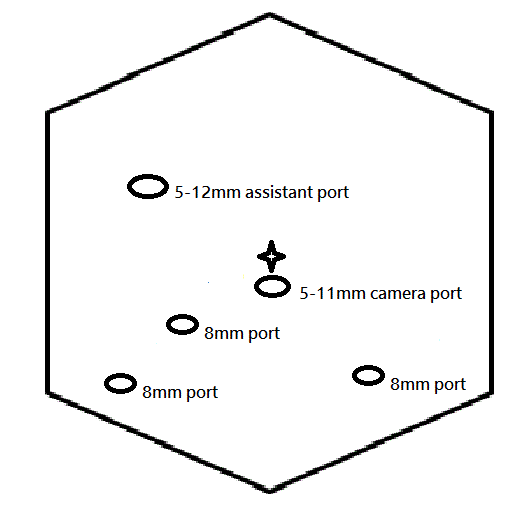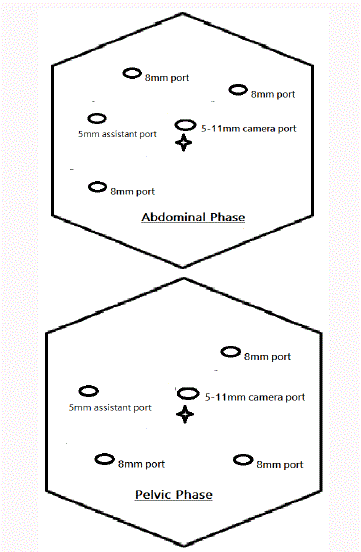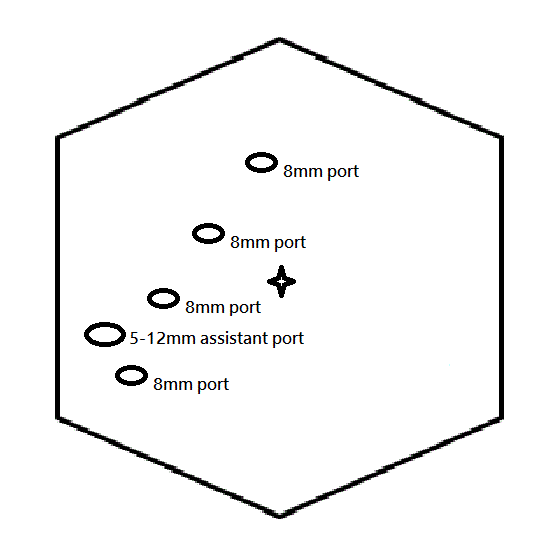Research Article
Does the Transition from da Vinci Si to Xi Platform Improve the Short-Term Outcomes for Rectal Cancer Surgery
Karen Tung Lok Man*, Lau Chi Wai and Michael Li Ka Wah Lupinski Ryszard1,2*
Department of Surgery, Pamela Youde Nethersole Eastern Hospital, Chai Wan, Hong Kong SAR, China
*Corresponding author: Karen Tung Lok Man, Department of Surgery, Pamela Youde Nethersole Eastern Hospital, Chai Wan, Hong Kong SAR, China
Published: 13 Jul, 2018
Cite this article as: Man KTL, Wai LC, Ka Wah ML. Does
the Transition from da Vinci Si to Xi
Platform Improve the Short-Term
Outcomes for Rectal Cancer Surgery.
Clin Surg. 2018; 3: 2014.
Abstract
Background: The newly introduced da Vinci Xi Surgical System was intended to address many of
the shortcomings of its predecessor Si, specifically robotic arm restrictions and difficulty working in
multiple quadrants. And the aim of this study was to compare the short-term outcomes of robotic
rectal cancer resection with the use of da Vinci Si (TME-Si) and new da Vinci Xi (TME-Xi).
Methods: From Jan 2016 to April 2018, 57 patients underwent robotic rectal cancer surgery were
included. Patient were classified into 2 groups (TME-Si, n=33 versus TME-Xi, n=24). The TME-Si
group was further subdivided into conventional hybrid (TME-Si-hybrid) and total robotic-single
docking (TME-Si-robot) approach. Patient characteristics, perioperative clinical outcomes and
complications, and pathological assessment were compared between these three groups.
Results: Demographic details were similar between all three groups. TME-Si-robot group had
a slight higher proportion of patient receiving neoadjuvant chemo-radiotherapy but it is not
statistically significant. The only significant result is the operative time, TME-Si-robot had the
longest operative time (208.4 min) followed by TME-Si-hybrid (196 min) and TME-Xi group (189.5
min), however, the results do not reach statistically significance. Other perioperative outcomes
including blood loss, conversion rate and length of hospital stay were all comparable. The clinical
leakage rate and early complication rates did not differ between TME-Si and TME-Xi and all can
be managed conservatively. Postoperative pathological assessment including staging status, lymph
nodes harvested and margin involvement were all similar between Si and Xi.
Conclusion: Both da Vinci Si and Xi led to similar short term outcomes for robotic cancer surgery.
However, the new generation Xi model did allow surgeon for easier docking and lesser arm collision
when performing multi-quadrant surgery.
Introduction
The role of laparoscopic colectomy for colonic cancer had already been well established in many large scale multi-centered randomized controlled trials and meta-analysis [1-3]. However, the status of laparoscopic rectal cancer surgery is not so concrete, still under many intensive discussion. Result from the CLASICC trial raised our concern due to high conversion rate and higher circumferential resection margin positivity rate in the laparoscopic arm [4]. This may be attributed from the inherent limitations of laparoscopic surgery, resulting in technical difficulties in pelvic exposure, precise rectal dissection with total mesorectal excision in the narrow pelvis as well as preservation of pelvic autonomic nerves. One of the major advances in recent decades is the introduction of da Vinci Surgical system, its 3D camera, tremor filter and 7-degree endowrist movement overcomes many of the limitation of laparoscopic surgery, and translated into clinical benefit such as low conversion rate, shorter learning curve and better functional outcomes. Nevertheless, human being should always strive for the best, cannot be easily satisfied with the present status. Da Vinci Si system had several shortcomings, such as robotic arm restrictions and difficulty working in multiple quadrant. The newly introduced da Vinci Xi Surgical System was intended to address many of the shortcomings of its predecessor Si. And the aim of this study was to compare the short-term outcomes of robotic rectal cancer resection with the use of da Vinci Si (TME-Si) and new da Vinci Xi (TME-Xi).
Patients and Methods
From Jan 2016 to April 2018, 57 patients underwent robotic rectal cancer surgery were included.
Patient were classified into 2 groups (TME-Si, n=33 versus TME-Xi,
n=24). The TME-Si group was further subdivided into conventional
hybrid (TME-Si-hybrid) and total robotic-single docking (TMESi-
robot) approach. Patient characteristics, perioperative clinical
outcomes and complications, and pathological assessment were
compared between these three groups.
Preoperative workup and preparation
Pre-operative workup includes colonoscopy with histological
confirmation, whole body Computer Tomography scan (CT) and
pelvic Magnetic Resonance Imaging (MRI). Multi-disciplinary
meeting involving surgeon, radiologist, oncologist and pathologist
was carried out every two weeks in our hospital, all newly diagnosed
rectal cancer cases would be discussed and a final management plan
would be made. For locally advanced disease (clinically T3 or above,
presence of nodal disease and threatened circumferential resection
margin) confirmed on MRI, neoadjuvant chemo-irradiation was
given. Bowel preparation protocol included low residue diet 3 days
before operation, fluid diet and Klean prep one day before operation.
Surgical procedure
All the patients in this study underwent robotic low anterior
resection with loop ileostomy covering. The robotic trocar placements
of different robotic approach were shown in figure 1-3. Lymph node
dissection was started around origin of the inferior mesenteric
artery and medial to lateral technique was used in all operations.
Splenic flexure was not routinely taken down, because in Chinese
population, the sigmoid colon is relatively long and incidence of
sigmoid diverticulitis was low as compared to western countries.
So tension free anastomosis can usually be created without splenic
flexure mobilization. Operations were performed according to the
accepted mesorectal excision principles. The specimen was extracted
through pfennenstiel incision, and end to end colorectal anastomosis
was performed using circular stapler.
Operative technique with da Vinci Si hybrid approach:
The hybrid approach combines laparoscopic left sided colonic
mobilization and vascular control with robotic technique for rectal
dissection. The robot was docked in between the legs.
Operative technique with da Vinci Si total robotic SINGLE
docking approach: We used the Korean technique in which the
surgery is divided into abdominal and pelvic phase. The robotic cart
is docked over the left hip of patient at a 45o. In the abdominal phase,
inferior mesenteric vessel ligation and left sided colonic mobilization
were performed using robotic system. On completion of abdominal
phase, the position of the robotic cart remained unchanged, but two
of the robotic arms are repositioned to different position to perform
pelvic dissection.
Operative technique with da Vinci Xi total robotic SINGLE
docking approach: The operative procedure in the Xi group was
totally robotic and single docking. And all the procedures were
completed without need for repositioning of the robotic arms.
Outcome measures
The outcomes measured included operative time, blood loss,
conversion rate, length of postoperative hospital stay and postoperative
morbidity. Operative mortality was defined as postoperative death
that occurred within 30 days after surgery. Anastomotic leakage was
defined as clinically (presented as peritionitis or faecal content from
drains) or radiologically (as confirmed by water soluble contrast
enema). Two designated pathologists were specifically requested
to evaluate the quality of mesorectum specimen. Pathological data
including pathological stages, number of harvested lymph nodes,
status of circumferential resection margin and distal margin were
analyzed.
Statistic
Statistical analysis was performed using the SPSS program. The
student t test was used for continuous variables. The categorical
variables were analyzed by the chi test or Fisher’s exact test. A twosided
p-value of less than 0.05 was considered significant.
Figure 1
Figure 2
Result
From Jan 2016 to April 2018, 57 patients underwent robotic rectal cancer surgery were included, 33 patients in Si and 24 patients in Xi group. The Si group was further subdivided into conventional hybrid (TME-Si-hybrid) and total robotic-single docking (TME-Si-robot) approach. The patients’ demographic characteristics were shown in Table 1. The three groups were similar in terms of age and sex. TMESi- robot group had a slight higher proportion of patient receiving neoadjuvant chemo-radiotherapy but it is not statistically significant. The perioperative clinical outcomes and complications were shown in Table 2. The only significant result is the operative time, TME-Sirobot had the longest operative time (208.4 min) followed by TMESi- hybrid (196 min) and TME-Xi group (189.5 min), however, the results do not reach statistically significance. Other perioperative outcomes including blood loss, conversion rate and length of hospital stay were all comparable. The clinical leakage rate and early complication rates did not differ between TME-Si and TME-Xi and all can be managed conservatively. The 30 days mortality rate is 0. Postoperative pathological assessment (Table 3) including staging status, lymph nodes harvested and margin involvement were all similar between Si and Xi.
Figure 3
Discussion
Da Vinci robotic system is one the major surgical advancement
in the last decade. Its high resolution 3D camera, 7 degree endowrist
movement and stable console, allowing surgeons to perform fine
dissection in deep and narrow working space. The safety and
feasibility of old Da Vinci Si system for rectal cancer surgery had
been well established [5,6], however, several technical difficulties
with the Si system did exist. Rectal cancer surgery is a multi-quadrant
surgery requires inferior mesenteric vessel control, mobilization
of descending and sigmoid colon, sometimes even requires taking
down splenic flexure if sigmoid colon is relatively short and
unhealthy and pelvic rectal dissection. As a result, dual docking or
even multiple docking of robot is necessary and which would lead to
increased operative time and increased workload. In order to tackle
this problem, different operative approaches have been developed
for robotic rectal cancer surgery, including conventional hybrid
approach and total robotic single docking approach. We practiced
the conventional hybrid approach for some time in our unit, it had
the benefit of avoiding dual docking of robot so as to shorten the
whole operative time and patient can still enjoy the benefit of robot
during the most crucial step – rectal dissection. One of the drawback
of this approach is that robot cannot be used for lympho-vascular
dissection so the lymph nodes harvested was the lowest among the
three groups, and the operative cost also increases as need to open a
set of laparoscopic instruments . We also performed the total robotic
Si single docking surgery, it had the benefit that robot can be used
for both lympho-vascular dissection and rectal dissection, and with
longer console time per case, the learning curve can be overcome
faster. However, we encountered frequent external collisions of Si
robotic arms which lead to much longer operative time.
The fourth generation robot, da Vinci Xi system was launched
with the aim to overcome many of the limitations of its ancestor. The
laser targeting system allows easier docking, boom-mounted system
with the flexible and mobile platform allow better anatomic access
in multi-quadrant surgeries, the thin arms and instruments offer
greater range of motion. It is a pity that our unit had not recorded
the docking times for all these included cases, but subjectively, our
surgical team including surgeon and nurses feel that Xi model had
much easier and faster docking as compared to Si model. Morelli and
his group had reported a mean difference of 6 minutes in docking
time between Si-TME (23.5 +/- 2.7 min) and Xi-TME (17.5 +/- 3.4
min) [7]. As for the overall operative time, both Morelli and Ozben
had reported significantly shorter operative time in the Xi-TME group
from their comparative studies, around 40 minutes shorter in Xi-
TME group in both studies [7,8]. Our data reported that Xi-TME had
the shortest operative time among the three groups but the result did
not reach statistically significance. We believed the reason was that
in Cantonese population, the sigmoid colon is relatively redundant
and incidence of sigmoid diverticulitis is low, so a tension-free
anastomosis can usually be performed without splenic flexure take
down, and all our included cases, in fact none of them required taking
down the splenic flexure. As for Western population, splenic flexure
taking down rate is much higher; giving the advantage of model Xi in
performing multi-quadrant surgery, the benefit of Xi over Si would
become more obvious. Our study has several limitations. First, it is a
retrospective study with limited sample size. Second, the cases were
operated by a wide range of different surgeons during different phase
of their learning curve. Third, the Xi cases are the initial case series
immediately after Xi installed in our unit, so surgeon and operating
staff may not get used to the new trocar position, robotic cart position
and new function so affecting the performance of Xi system.
Table 1
Table 2
Table 3
Conclusion
Both da Vinci Si and Xi led to similar short term outcomes for robotic cancer surgery. However, the new generation Xi model did allow surgeon for easier docking and lesser arm collision when performing multi-quadrant surgery and also reducing the operative cost as no more hybrid approach was required in performing rectal cancer surgery.
References
- Lacy AM, García-Valdecasas JC, Delgado S, Castells A, Taurá P, Piqué JM, et al. Laparoscopy-assisted colectomy versus open colectomy for treatment of non-metastatic colon cancer: a randomized trial. Lancet. 2002;359(9325):2224-9.
- Veldkamp R, Kuhry E, Hop WCJ, Jeekel J, Kazemier G, Bonjer HJ, et al. Laparoscopic surgery versus open surgery for colon cancer: short term outcomes of a randomized trial. Lancet Oncol. 2005;6(7):477-84.
- Aly EH. Laparoscopic colorectal surgery: summary of the current evidence. Ann R Coll Surg Engl. 2009;91(7):541-4.
- Guillou P, Quirke P, Thorpe H, Walker J. Short-term endpoints of conventional versus laparoscopic-assisted surgery in patients with colorectal cancer (MRC CLASSIC trial): multicenter, randomized controlled trial. The Lancet. 2005;365:1718-26.
- Trastulli S, Farinella E, Cirocchi R, Cavaliere D, Avenia N. Robotic resection compared with laparoscopic rectal resection for cancer: Systematic review and meta-analysis of short-term outcomes. Colorectal Dis. 2012;14:e134-56.
- Xiong B, Ma L, Zhang C, Cheng Y. Robotic versus laparoscopic total mesorectal excision for rectal cancer: A meta-analysis. J Surg Res. 2014;188:404-14.
- Luca M, Gregorio DF, Simone G. Robotic-assisted total mesorectal excision for rectal cancer: case-matched comparison of short-term surgical and functional outcomes between the da Vinci Xi and Si. Surg Endosc. 2018;32:589-600.
- Volkan O, Turgut B, Deniz A. Is da Vinci Xi better than da Vinci Si in robotic rectal cancer surgery? Comparison of the 3 generations of da Vinci systems. Surg Laparosc Endosc Percutan Tech. 2016;26:417-23.




